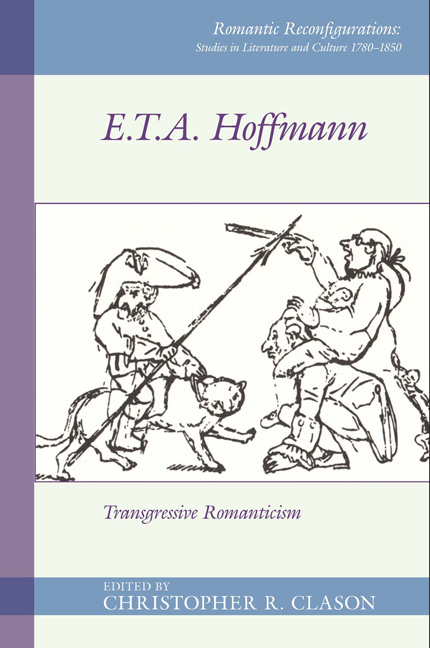Book contents
- Frontmatter
- Contents
- List of Figures
- Acknowledgements
- Notes on Contributors
- Introduction
- I Transgression and Institutions
- II Transgression and the Arts
- 4 E.T.A. Hoffmann and the Bamberg Theater
- 5 Transitions and Slippages of Mimesis in E.T.A. Hoffmann's “Der goldene Topf,” “Die Fermate,” and “Das öde Haus”
- 6 Transgressions: On the (De-)Figuration of the Vampire in E.T.A. Hoffmann's “Vampyrismus”
- III Transgression in the Märchen
- IV Transgression of Reception in Kater Murr
- Works Cited
- Index
5 - Transitions and Slippages of Mimesis in E.T.A. Hoffmann's “Der goldene Topf,” “Die Fermate,” and “Das öde Haus”
from II - Transgression and the Arts
- Frontmatter
- Contents
- List of Figures
- Acknowledgements
- Notes on Contributors
- Introduction
- I Transgression and Institutions
- II Transgression and the Arts
- 4 E.T.A. Hoffmann and the Bamberg Theater
- 5 Transitions and Slippages of Mimesis in E.T.A. Hoffmann's “Der goldene Topf,” “Die Fermate,” and “Das öde Haus”
- 6 Transgressions: On the (De-)Figuration of the Vampire in E.T.A. Hoffmann's “Vampyrismus”
- III Transgression in the Märchen
- IV Transgression of Reception in Kater Murr
- Works Cited
- Index
Summary
Introduction
Much has been written on the work of E.T.A. Hoffmann but so far little has been clarified about his specific contributions to the ongoing debate on mimesis. It is Hoffmann who argues in the introduction to his story “Das öde Haus” that sometimes reality as it truly is may be more surprising, marvelous, or uncanny than any fictional narrative, thus unsettling the expected hierarchy between nature and art, outer and inner worlds. This essay explores how Hoffmann challenges, even more than Lessing before him, the ut pictura poesis tradition and the idea of the “sister arts,” concerning the similarity, or rivalry, between painting and poetry, the visual and the verbal. Lessing in his famous 1755 essay “Laokoon: Oder über die Grenzen der Malerei und Dichtkunst” in response to Winckelmann's notion of imitation based on Greek Antiquity proposed that the visual arts belong to the dimension of space, whereas Dichtkunst (“Literature”) oscillates between the visual (its “Zeichen” or “signs” he calls “Körper im Raum” or “bodies in space” arranged sequentially) and the acoustic (its signs he calls “Töne” or “sounds,” “übereinander” or “with simultaneity”). Long before Jean Baudrillard, who suggested that simulacra replace mimetic relations in the twentieth century, Hoffmann already seems to suggest that the mind creates so many of the images we see and that memories are fictional, perhaps even when their recollection seems most realistic to us. Three narratives in particular written by Hoffmann between 1814–17 indicate a development in his style of representation that finds him experimenting with unstable signifiers and imaginative technologies, that suggest increasing degrees of a person's removal from what could be safely referred to as the “real,” into a realm of the hyperreal that involves reified images and objects of a different nature, his realm of art.
Hoffmann had studied painting at secondary school before he began legal studies at the University of Königsberg in 1792. After completing his degree, in 1800 he obtained a position as a legal councilor in the Highest Court (“Assessor am Obergericht”) in Posen. Then he became acquainted with Zacharias Werner and Julius Eduard Hitzig, who introduced him to the ideas of Romanticism. In 1805 Hoffmann created a “Singspiel” based on a text by Clemens Brentano in which he links the disciplines of art, fusing vocal music and theatre.
- Type
- Chapter
- Information
- E. T. A. HoffmannTransgressive Romanticism, pp. 96 - 113Publisher: Liverpool University PressPrint publication year: 2018



